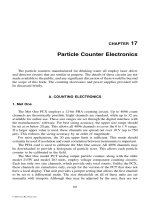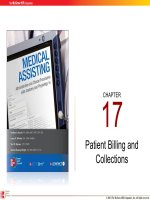Lecture Clinical procedures for medical assisting (4/e): Chapter 17 – Booth, Whicker, Wyman
Bạn đang xem bản rút gọn của tài liệu. Xem và tải ngay bản đầy đủ của tài liệu tại đây (1.03 MB, 43 trang )
CHAPTER
17
Collecting,
Processing, and
Testing Blood
Specimens
© 2011 The McGraw-Hill Companies, Inc. All rights reserved.
172
Learning Outcomes
17.1 Discuss the composition and function of
blood.
17.2 Describe the process for collecting a blood
specimen.
17.3 Explain the importance of confirming patients’
identities and correctly identifying blood
samples.
17.4 Describe how to perform venipuncture and
capillary puncture procedures.
© 2011 The McGraw-Hill Companies, Inc. All rights reserved.
173
Learning Outcomes (cont.)
17.5 Identify the equipment and supplies required
for blood-drawing procedures.
17.6 Discuss the correct procedures for disposing
of waste generated during blood-drawing
procedures.
17.7 Discuss common fears and concerns of
patients and how to ease these fears.
© 2011 The McGraw-Hill Companies, Inc. All rights reserved.
174
Learning Outcomes (cont.)
17.8 Develop techniques for helping patients with
special needs, including children, the elderly,
patients at risk for uncontrolled bleeding, and
difficult patients.
17.9 Identify common blood tests and explain
their purposes.
17.10Perform certain blood tests.
© 2011 The McGraw-Hill Companies, Inc. All rights reserved.
175
Introduction
• Medical assistant
– Collects blood specimens
– Performs waived testing
– Knowledge needed
• Understand circulatory system and function of
blood
• Appropriate supplies and equipment
• How to perform and screen common blood tests
© 2011 The McGraw-Hill Companies, Inc. All rights reserved.
176
Role of the Medical Assistant
• Phlebotomy – insertion of a
needle or cannula into a vein
to withdraw blood
• Put the patient at ease during
procedure
• Process specimens and conduct testing
• Complete necessary paperwork and make
sure specimens are handled properly
© 2011 The McGraw-Hill Companies, Inc. All rights reserved.
177
Functions and Composition of Blood
• Circulatory system transports blood
– Heart pumps 8–12 pints of blood
through 70,000 miles
of vessels/day
• Hematology – the study of blood
© 2011 The McGraw-Hill Companies, Inc. All rights reserved.
178
Functions and Composition of Blood (cont.)
•
Functions of blood
– Distributes oxygen, nutrients,
and hormones
– Eliminates waste products
– Attacks infecting pathogens
– Maintains acid-base balance
– Regulates body temperature
© 2011 The McGraw-Hill Companies, Inc. All rights reserved.
179
Functions and Composition of Blood (cont.)
• Red blood cells – erythrocytes
– Internal respiration
– Transport oxygen to cells
• Hemoglobin – 98%
• Dissolved in plasma – 2 to 3 %
– Hemoglobin
• Main component of RBCs
• Protein containing iron
© 2011 The McGraw-Hill Companies, Inc. All rights reserved.
1710
Functions and Composition of Blood (cont.)
• White blood cells – leukocytes
– Protect against infection
– Granular
• Basophils
• Eosinophils
• Neutrophils
– Agranular
• T and B lymphocytes
• monocytes
© 2011 The McGraw-Hill Companies, Inc. All rights reserved.
1711
Functions and Composition of Blood (cont.)
• Platelets –
thrombocytes
– Fragments of
cytoplasm
– Essential for clot
formation
• Plasma
– Clear, yellow liquid
– Contains formed
elements of blood
– 90% water
• Serum – clear, yellow
liquid remaining after
clot formation
© 2011 The McGraw-Hill Companies, Inc. All rights reserved.
1712
Functions and Composition of Blood (cont.)
• Blood types or groups
– Presence of antigens A and B
determines type
– Blood also carries antibodies
• Transfusions require careful matching
to prevent hemolysis
© 2011 The McGraw-Hill Companies, Inc. All rights reserved.
1713
Apply Your Knowledge
1. What is the role of the medical assistant related to
collecting blood samples?
ANSWER: The medical assistant will put the patient at
ease during the procedure, process specimens,
conduct testing, complete necessary paperwork, and
make sure specimens
are handled properly.
© 2011 The McGraw-Hill Companies, Inc. All rights reserved.
1714
Apply Your Knowledge
2. What are three functions of blood?
ANSWER: Functions of the blood are: (list any 3)
1. Distributes oxygen, nutrients, and hormones
2. Eliminates waste products
3. Attacks infecting pathogens
4. Maintains acid-base balance
5. Regulates body temperature
© 2011 The McGraw-Hill Companies, Inc. All rights reserved.
1715
Collecting Blood Specimens
• Reading and
interpreting the
test order
– Review order
– Assemble equipment
and supplies
• Preparing the patient
– Greet and identify the
patient
– Confirm pretest
preparation
– Explain the procedure
and safety precautions
– Establish chain of
custody
© 2011 The McGraw-Hill Companies, Inc. All rights reserved.
1716
Collecting Blood Specimens (cont.)
• Use Standard Precautions and PPE as
needed
• Handling exposure incident
– Needlestick or other exposure to blood/blood
products
– Report to appropriate person immediately
– Wash area and apply bandage
– Document date, time, people involved, type of
exposure
© 2011 The McGraw-Hill Companies, Inc. All rights reserved.
1717
Drawing Blood
•
Not all states permit
medical assistants to
draw blood
•
Venipuncture
– Puncture of a vein
– Most common sites
are in the antecubital
fossa and forearm
Common Sites for
Venipuncture
© 2011 The McGraw-Hill Companies, Inc. All rights reserved.
1718
Collecting Blood Specimens (cont.)
•
Venipuncture
complications
– Hematoma
•
•
Hold needle still
Hold pressure on site
after removal of
needle
– Nerve injury
•
– Infections
•
– Latex allergy
•
•
Ask patient
Use non-latex gloves,
tourniquet, and
bandages
Know anatomy
•
•
Rare
Clean site prior to
venipuncture
May not be evident for
several days
© 2011 The McGraw-Hill Companies, Inc. All rights reserved.
1719
Collecting Blood Specimens (cont.)
•
Equipment
– Evacuation systems – use special doublepointed needle, needle holder
– Needle and syringe systems
– Butterfly system – winged infusion set and
syringe
– Collection tubes
•
•
Sealed to create a vacuum
Color-coded to identify appropriate additive
© 2011 The McGraw-Hill Companies, Inc. All rights reserved.
1720
Collecting Blood Specimens (cont.)
•
Engineered safety devices
– Reduce the possibility of needlestick
injuries
– Types
•
•
•
•
Retracting needles
Hinged or sliding shields
Self-blunting needles
Retractable lancets
© 2011 The McGraw-Hill Companies, Inc. All rights reserved.
1721
Collecting Blood Specimens (cont.)
•
Capillary puncture
– Superficial puncture of
skin with sharp point
– Reagent products –
chemically treated
paper or dipstick
– Lancets – small,
disposable instruments
– Smear slides
– Automatic puncturing
devices
– Micropipettes – small,
calibrated glass tubes
that hold a precise
volume of fluid
© 2011 The McGraw-Hill Companies, Inc. All rights reserved.
1722
Apply Your Knowledge
What precautions should you take when collecting
a blood specimen?
ANSWER: You should use Standard Precautions and
appropriate personal protective equipment.
© 2011 The McGraw-Hill Companies, Inc. All rights reserved.
1723
Responding to Patient Needs
• Respond with sensitivity and competence
• Fears and concerns
– Pain
– Bruises or scars
– Serious diagnosis
– Contracting a disease from the procedure
© 2011 The McGraw-Hill Companies, Inc. All rights reserved.
1724
Special Considerations
•
Children
– Talk with parent or caregiver first
– Address child directly
– Speak in a calm, soothing voice
– Explain the procedure briefly in terms they can
understand
– Keep child informed of status during the procedure
© 2011 The McGraw-Hill Companies, Inc. All rights reserved.
1725
Special Considerations (cont.)
•
Elderly
– Prone to bruising
– Difficult to obtain an adequate sample
– Speak clearly in a low-pitched voice
– Allow adequate time for patient to respond to
questions
© 2011 The McGraw-Hill Companies, Inc. All rights reserved.









